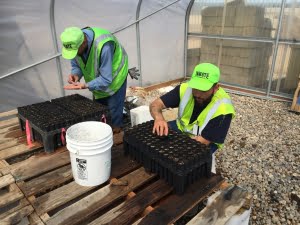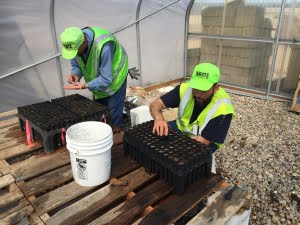
Snake River Correctional Institute Inmates sow 60,000 native plants for restoration
By Stacy Moore
April 2019
At the Snake River Correctional Institution (SRCI) in Ontario, Oregon, inmate Whitecalf carefully waters hundreds of trays of soil sprinkled with minuscule sagebrush seeds. Nearby, two other inmates use a seeding tool to place approximately 5-7 seeds on top of the loam in each "conetainer," a cone-shaped pot that allows for easy planting of plugs in the fall. Together they are a segment of the 15-person inmate team in the Sagebrush in Prisons project. The project is an ecological educational certificate program involving 10 prisons in five Western states, in collaboration with Institute for Applied Ecology (IAE), a non-profit in Corvallis, Oregon, the Bureau of Land Management, (BLM) and Department of Corrections. Since 2014, IAE is grateful that the BLM has sponsored the Sagebrush in Prisons project, which planted its one-millionth sagebrush seedling in 2018 in threatened greater sage-grouse habitat.
“In my six years of incarceration, I have never been part of something with such a positive impact," said Mr. Whitecalf. “This project is a learning experience; I see how delicate our environment is and the impacts of our human footprint.” SRCI, with leadership from IAE and funding from BLM, was the first prison to start growing sagebrush plugs in 2014.
The goal of the program is to help restore habitat of the greater sage-grouse and other wildlife that has been devastated by wildfire burns. The iconic greater sage-grouse once numbered 16 million individuals. Due largely to habitat loss, the birds’ number 200,000 – 500,000 currently. Inmates are now helping to improve those numbers.




To date, SRCI has grown 175,564 native plants that have gone out on local native landscapes. Nancy DeWitt, IAE contractor, works alongside inmates and coordinates the growing of the sagebrush with Vale BLM field office. “This program not only helps rehabilitate acreage scorched by wildfire, but it helps provide job skills for inmates,” she commented.
During the week of April 22, 2019, a team of inmates thoroughly mixed bags of soil and then fill 60,000 conetainers with soil followed by seeding. Within 3-5 days the first seeds germinated, creating a blanket of green within the prison greenhouse. Inmates will water the plants twice a day and later thin and fertilize the plants for the next 7 months. Come November, participants will box up their now 6-12” plants. Selected inmates will assist the BLM in planting the plants on greater sage-grouse habitat that is in need of restoration.
As part of the program, inmate Rodriguez scoops soil on top of a tray cover and pours in the mixture. “It is great working with a team for a common goal. I feel I am giving back to the community. This program gives inmates job readiness skills, and help us with the transition for release, says Mr. Rodriguez. "It helps us get our lives back on track.”
Read more about the Sagebrush in Prisons project here.


Restoration
Research
Education
Get Involved
Contact
Main Office:
4950 SW Hout Street
Corvallis, OR 97333-9598
541-753-3099
[email protected]
Southwest Office:
1202 Parkway Dr. Suite B
Santa Fe, NM 87507
(505) 490-4910
[email protected]
© 2024 Institute for Applied Ecology | Privacy Policy